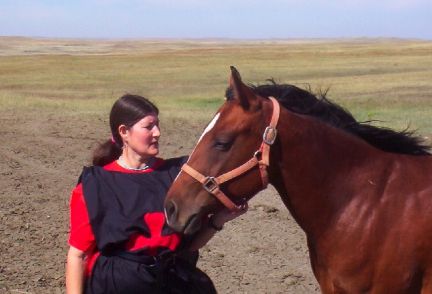|
Fencing, Jousting and Daggers
The contents of this page, Fencing, Jousting and Daggers, is still under construction. It may be for a very long time.....as I learn more and more about each element of Medieval Jousting, Swords and Daggers myself. Please check back often!
Lovely to look at
romantic to hold.
but in the hands of the unyielding
his life as it was may be told.

Part of the allure to the Renaissance times is the Weapons, the Knights, the War Horses, the Armor, the Hand to Hand Combat.
Using a sword or dagger correctly or precisely does not just happen. It is not "born in" it is learned in a respectful manner.
Knights became Knights after long hard hours of not just sword wielding, but also other disciplines. First a Knight was a Page as a child or young boy, then if he proved himself he became a Squire. As a Squire he had to prove himself worthy and brave and respectful before being Knighted.
So my point is.....if you did not already get it. <grin> Is if you do not know about swords and daggers find someone that does know about them and ask them to teach you the proper use. Like guns, these items can be deadly and accidents happen.

I have read, in horse history, that Knight's had three horse types that they rode. The largest, what they called "Grandest", or "great horses" were the type called "Destriers". These large bred horses were used for battles, tournaments and jousts. When speed and agility were important the Knight would ride his "Courser". From the historic description, it sounds like a modern day "cutting horse" to me. For everyday transportation the same Knight would ride a horse type called "Rounceys" The Rouncey was a smaller, all purpose horse.
Jousting and or war horses had to be trained for battle. They had to be taught to wear and carry the amour and weapons as well as be desensitized to all the action and noise. A knight would train his horse, as one should today, to walk toward a tree (telephone pole) as he puts out his jousting pole to hit the tree. The horse needed, needs, to feel the stop and hear the noise as well as see the pole coming up from behind and above as it comes forward to hit the tree. After the horse does well at a walk, then you teach the same at a trot and so fourth.
The horse in this photo is a horse I hope to ride wearing Medieval flowing clothing and do some Ring Jousting while riding on her. She is a young filly, not yet broke out, and I am working with her with those types of things as I train her.
If you are planning on riding a horse in Renaissance Garb and or Jousting, you will need to desensitize the animal to the flowing, blowing, clothing fist. It may take a long time with some horses and some may never get used to the idea of the monster you are wearing to be on it's back.
I am always amazed how many people think that a horse, any horse, can be used for jousting... Not just any horse, but any horse at any moment, with no additional training, they believe, can be garbed up, mounted in flowing clothing and headed at a full gallop while the rider carries things such as swords and or jousting lances.
I have an advantage with my horses. My horses came up with their own idea of how to keep flies off their bodies by just standing still. Our horses are not fenced out of our home area and when I hang my laundry the devils will stand in the middle of it, as they have found that it keeps the bugs off without one flip of the tail. How does this help my fencing and flowing, blowing garb training? My horses are used to blowing fabrics. They stand in the laundry so they are very used to the clothing hitting them on their bodies....and me coming out to yell at them to move on. My horses even know how to walk within the lines, I have four stands of rope, and not get twisted or caught.....the devils. <she grins>
more to come
SERAPIES, CAPARISON, BARDS AND OR BARDING
Dressing the Horses. Maybe my own personal favorite of all the Renaissance era glamor. Of all the pictures and all the costumes, the ones on the Jousting or Riding Horse are my favorite. Be it the flowing bards or the armor, or even just the riders cloak cut long and flowing over the back of a cantering horse.
Call it what you like, choose the type of Renaissance Horse Costume you like best, or the type that matches the best to your own garb, but know that outfitting the Medieval Horse will not be inexpensive. Even if you make the costume yourself, it takes a lot of fabric for most of the Medieval Horse Costumes and lots of trim. You will need a lot of room to work the large pieces of fabric in, and it will take a lot of time. You will soon find out why those items are so expensive. Even an 18" Serapie, that is 2 1/2" yards long, that rides behind the saddle, with the fancy trim, will cost quite a bit to make. If you want lettering on that, more time, more work and more money.
If you are thinking you would like to have the metal armor, and come on, who would not, you need to have deep pockets. Much time and work and metal go into Medieval Horse Armor, not too mention that the patterns used must be precise for it to work/move correctly on the horse it is made for.
Fit is very important when dressing your animals. You do not want your horse to trip over any flowing garb. You also do not want their eyes covered wrongly with a head dressing.
You need to think about the sport or sports you will be participating in before deciding on your horse garb. If you live in a windy weather area, you would not want a front piece, over the horses shoulders, to come blowing back at you as you are trying to shoot an arrow from a bow. Or at least use the type that comes back under the saddle/rider's leg.
coming soon....
SWORD FIGHTING AND FENCING I don't know anything about handling a sword. But I know enough to leave them alone unless under instruction from someone who does know who to handle them and handle them well. This person will be certified.
Other wise, if you just go out and buy a sword to "play with", you are wielding a deadly weapon and holding quite a liability.
more to come
Oooohhhhhh, they are so pretty and romantic and so Medieval looking to have hanging from a belt. They look KOOOOOL and are so useful.....in the right hands. But dangerous indeed! We have a friend that has several swords and daggers. When in garb he carries many...but he does it the way it is suppose to be done, safely. He is very careful around his children, or I should say that he and his wife are always making the children aware of the dangers as they (the parents) are always aware of where the children are and very careful with the weapons. The weapons have sheaths and hang correctly from their garb.
We have all seen the guy, and it does look KOOOOL that has the sharp dagger tucked into his belt without a sheath. We have all thought "What is he thinking", as he moves about and or goes to sit down with that sharp end ready to cut his own body badly.
more to come....
STILL WORKING ON THIS PAGE
-- The Renaissance Rats Team
Thu, 18 Dec 2008 21:59:55 -0500
| 



 In the high plains of South Dakota, USA
In the high plains of South Dakota, USA In the high plains of South Dakota, USA
In the high plains of South Dakota, USA